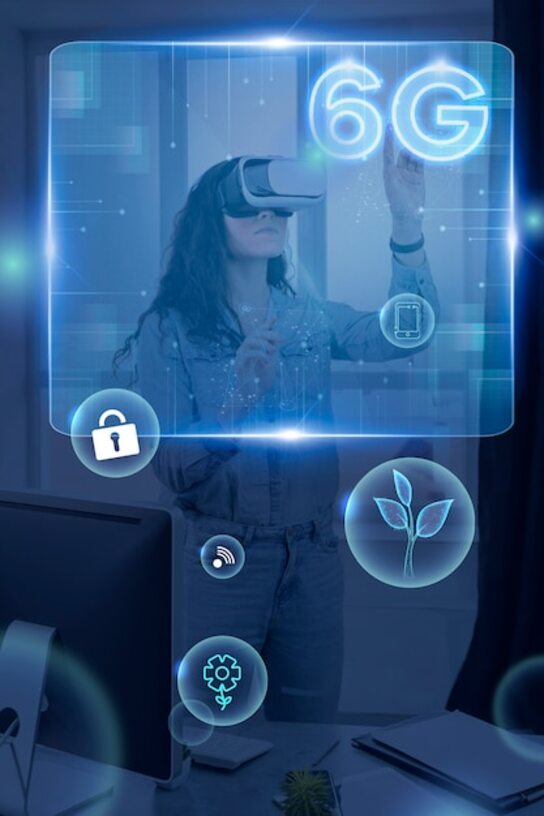Redefining home security with augmented reality technology

Rediscovering home security has never been so exciting thanks to augmented reality technology. Imagine being able to monitor and manage your security from the comfort of your sofa, visualizing in real time the vulnerable areas of your house. This innovative technology not only transforms our perception of home protection but also provides accessible and effective tools to keep safe what we value most. In this article, we will explore how augmented reality is revolutionizing the concept of home security.
What is augmented reality and how is it applied to home security?
Augmented reality (AR) is a technology that overlays digital information, such as images and data, onto the real world through devices like smartphones, tablets, or smart glasses. In the context of home security, this tool allows users to visualize security elements, such as cameras and sensors, in their physical environment through an intuitive interface. For example, by pointing a device at a room, the user can see in real-time the areas that need reinforcement or the optimal locations to install surveillance systems. This direct interaction helps identify vulnerabilities that could be overlooked in a conventional visual analysis.
In addition to facilitating visual supervision, augmented reality also offers interactive simulations that allow homeowners to experience different security configurations before implementing them. Imagine being able to virtually move a security camera or adjust the position of a sensor from your living room without the need for immediate physical changes. This approach not only optimizes the arrangement of devices but also empowers users by giving them a more comprehensive understanding of how each component contributes to their overall protection. Thus, AR becomes an invaluable ally for those looking to maximize security in their homes effectively and conveniently.
2. Key benefits of implementing augmented reality in security systems.
The implementation of augmented reality (AR) in home security systems offers key benefits that transform the way homeowners interact with their protection devices. One of the most significant advantages is the ability to visualize alerts and activities in real time, allowing users to have complete control over their environment. By using an AR-compatible application, it is possible to overlay digital information onto images of the home, facilitating the immediate identification of vulnerable areas, blind spots, or even tracking suspicious movements. This not only improves the response to potential incidents but also provides a more intuitive and accessible experience for all family members.
Another important benefit is the customization and adaptation of the security system according to the specific needs of each home. Through augmented reality, users can conduct interactive simulations that allow them to experience how different configurations affect their security. For example, they can test different positions for cameras or sensors before making a final installation. This flexibility not only optimizes the existing system but also empowers homeowners by making them active participants in the design and management of their own security. Ultimately, this fosters greater peace of mind knowing that their home is protected by a system specifically tailored to their requirements and lifestyle.
3. Comparison: Traditional systems vs. augmented reality solutions.
The comparison between traditional security systems and augmented reality solutions reveals a paradigm shift in how we approach home protection. Conventional systems, such as alarms and surveillance cameras, offer basic functionality focused on detection and response to intrusions. However, they often lack interactivity and customization, which can limit their effectiveness. On the other hand, augmented reality-based solutions allow homeowners to visualize their environment in real time, identify weak points, and receive instant notifications about suspicious activities. This capability for interactive visualization not only enhances the perception of security but also empowers users to make informed decisions about preventive measures.
Additionally, while traditional systems often require a significant investment in hardware and constant maintenance, augmented reality applications can easily integrate with existing devices and provide a more accessible experience. These platforms allow for simulating risk scenarios and training users on how to react to different situations, all from their mobile device or tablet. This proactive approach not only increases the user's confidence in their ability to manage home security but also fosters a culture of active prevention against potential threats. In summary, when contrasting both approaches, it becomes clear that augmented reality is redefining the very concept of home security, making it more dynamic and intuitive.
4. How to choose the right equipment to integrate augmented reality into your home.
When choosing the right equipment to integrate augmented reality into your home, it is essential to consider several key features that will optimize your experience. First, check that the devices are compatible with the augmented reality applications you plan to use. This includes reviewing technical requirements such as processing power and internet connectivity. Also, ensure that they are easy to install and operate, as unnecessary complexity can discourage their use. Opting for well-known brands in the field of smart home technology usually guarantees quality and technical support.
Also, consider the type of interactive content you want to experience with augmented reality. Some devices are specifically designed to offer 3D visualizations or simulations that will help you identify vulnerable points in your home. Others may include security cameras with integrated AR capabilities, allowing you to overlay information on what you are seeing in real time. Finally, do not forget to evaluate the opinions of other users regarding the performance and effectiveness of the device; this will give you a clearer insight into which option best fits your specific needs and how it can enhance the overall security of your home.
5. Practical cases: Costa Rican households that have improved their security.
In Costa Rica, several households have adopted augmented reality technology to enhance their security, achieving surprising results. For example, a family in San José implemented a system that allows them to visualize in 3D the possible entry and exit points of their home through their mobile device. This has enabled them to identify vulnerable areas that previously went unnoticed, such as hard-to-see windows or poorly lit back entrances. Thanks to this interactive visualization, they have reinforced those critical points with better locks and lighting systems, thereby increasing the overall security of the home and providing greater peace of mind to its residents.
Another highlighted case is that of a couple in Guanacaste who decided to integrate security cameras with augmented reality capabilities into their home. Using a specific application, they can see in real-time the status of each room from anywhere. Additionally, the overlay functionality shows them alerts about unusual movements and areas that require immediate attention. The ability to interact with their environment digitally has not only allowed them to prevent criminal incidents but also to better manage the care of their children and pets while they are away. These examples demonstrate how technology can be a powerful ally in the protection of the Costa Rican home.
6. The evolution of security technology: From CCTV to augmented reality.
The evolution of security technology has come a fascinating way, from traditional CCTV systems to the more sophisticated solutions offered by augmented reality. Closed-circuit cameras have been an essential tool for monitoring our homes for years, providing real-time images and recordings that can be reviewed later. However, their focus was limited to passive observation, leaving homeowners with the responsibility of interpreting what was happening on their properties. With the advent of augmented reality (AR), this dynamic has changed radically, allowing not only to see but to interact with the environment in real time. Augmented reality takes home security to a new level by overlaying digital information onto the physical world. For example, through mobile devices or AR glasses, users can visualize alerts and relevant data about sensitive areas of their home while walking through them. This means that we can not only see who is at our door or detect unusual movements, but we can also receive immediate recommendations on how to act in response to potential threats. This integration transforms our ability to manage home security, turning what was once mere surveillance into an interactive and proactive experience.
The convergence of these technologies promises a future where home protection is not only more effective but also more accessible. Thus, the transition from CCTV to AR-based solutions reflects a significant advancement towards a comprehensive and adaptive approach to keeping our space safe and secure.
7. Common myths about augmented reality in home security.
Augmented reality (AR) has given rise to a series of myths that can distort its true utility in home security. One of the most common is the belief that this technology is too complicated for the average user. However, AR applications have been designed with accessibility in mind, allowing anyone, regardless of their technological level, to easily manage and monitor their home security. Intuitive tutorials and user-friendly interfaces make implementation and daily use straightforward, thereby removing any initial barriers for those looking to protect their spaces.
Another common misconception is thinking that augmented reality is only about eye-catching visualizations and does not provide real value to home security. In reality, AR applications allow for detailed analysis and simulations that help identify weak points in security. For example, by overlaying information on vulnerable areas or possible access routes for intruders, users can make informed decisions about how to strengthen their protection. Thus, far from being merely an aesthetic tool, augmented reality becomes a strategic ally in creating safer and more reliable home environments.
8. Tips to maximize the use of augmented reality applications in surveillance.
To maximize the use of augmented reality applications in surveillance, it is essential to become familiar with the specific features that these tools offer. Start by exploring all the available functions, from the 3D visualization of your home to the ability to integrate cameras and motion sensors. The ability to overlay useful information onto the real environment will allow you to identify critical points and vulnerable areas. Additionally, make sure to customize alerts and notifications according to your needs, which will keep you informed about any suspicious activity in real time.
Another essential strategy is to integrate these applications with other smart home devices. By connecting cameras, lights, and alarm systems, you can create a cohesive ecosystem that not only enhances security but also facilitates management. For example, by activating an outdoor light through the app when you detect unusual movement, you can deter potential intruders. Likewise, consider setting up automatic routines that trigger based on your location or specific schedules; this not only optimizes your surveillance system but also adds an extra layer of protection without requiring constant intervention.
9. Future of home security: Trends in emerging technology.
The future of home security is seen as full of possibilities thanks to emerging technologies that complement augmented reality. Among these, artificial intelligence (AI) will play a fundamental role in analyzing behavior patterns and detecting suspicious activities in real time. Imagine surveillance systems that not only record but also learn from your daily habits and alert you to any anomalies. This integration will enable unprecedented personalization, where each home can have a solution tailored to its specific needs, making security proactive rather than just reactive.
Similarly, the Internet of Things (IoT) is transforming home devices into interconnected elements capable of communicating with each other. Security cameras, smart locks, and sensors can be controlled through mobile applications that use augmented reality to provide an intuitive and 3D visualization of the environment. This not only facilitates monitoring from anywhere but also empowers users by allowing them to interact with their devices in a more natural and effective way. As these technologies continue to evolve and integrate into our daily lives, the traditional perception of home security will change radically, providing a renewed sense of protection and peace of mind to homeowners.
10. Recommended resources and tools to get started with augmented reality at home.
To start integrating augmented reality into your home and improve security, it is essential to have the right resources and tools. There are mobile applications that allow you to visualize the status of your security devices, such as surveillance cameras and alarms, in real-time through an interactive virtual environment. These applications are intuitive and often provide tutorials that facilitate learning. In addition, some manufacturers of security systems have begun to incorporate augmented reality features into their products, allowing for easier setup and a more enriching user experience.
Another valuable tool is augmented reality devices, such as glasses or headsets that can provide you with an expanded view of your home environment. These devices can overlay relevant information about the areas you want to monitor, such as critical points where greater attention is required or even alerts about potential threats. Finally, do not underestimate the power of online communities; forums and social networks can be excellent sources for sharing experiences and tips on how to maximize the use of augmented reality in home security. With these tools at your disposal, you will be well-equipped to take the first step toward a safer and more innovative home.



